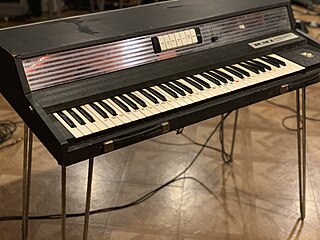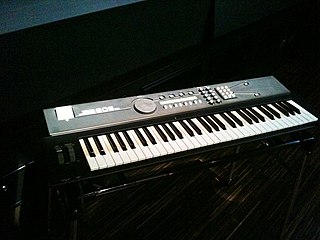
An electronic musical instrument or electrophone is a musical instrument that produces sound using electronic circuitry. Such an instrument sounds by outputting an electrical, electronic or digital audio signal that ultimately is plugged into a power amplifier which drives a loudspeaker, creating the sound heard by the performer and listener.

An analog synthesizer is a synthesizer that uses analog circuits and analog signals to generate sound electronically.
Keytar is a keyboard instrument similar to a synthesizer or MIDI controller that is supported by a strap around the neck and shoulders, similar to the way a guitar is held.

The Yamaha CS-80 is an analog synthesizer introduced by Yamaha Corporation in 1977. It supports true 8-voice polyphony, with two independent synthesizer layers per voice each with its own set of front panel controls, in addition to a number of hardwired preset voice settings and four parameter settings stores based on banks of subminiature potentiometers.
The Yamaha AN1x is a DSP-based analog modeling synthesizer, produced by Yamaha Corporation from 1997 to 1998, and was marketed as an "analog physical modelling control synthesizer".
Sequential is an American synthesizer company founded in 1974 as Sequential Circuits by Dave Smith. In 1978, Sequential released the Prophet-5, the first programmable polyphonic synthesizer, which was widely used in the music industry. In the 1980s, Sequential was important in the development of MIDI, a technical standard for synchronizing electronic instruments.

The Jupiter-8, or JP-8, is an eight-voice polyphonic analog subtractive synthesizer introduced by Roland Corporation in early 1981.
Monotimbral is usually used in reference to electronic synthesizers which can produce a single timbre at a given pitch when pressing one key or multiple keys.

The Yamaha GX-1, first released as Electone GX-707, is an analog polyphonic synthesizer organ developed by Yamaha as a test bed for later consumer synths and Electone series organs for stage and home use. The GX-1 has four synthesizer "ranks" or three manuals, called Solo, Upper, and Lower, plus Pedal, and an analog rhythm machine. The GX-707 first appeared in 1973 as a "theatre model" for use on concert stages, before the GX-1 was publicly released in 1975.

Rocky Mount Instruments (RMI) was a subsidiary of the Allen Organ Company, based in Rocky Mount, North Carolina, active from 1966 to 1982. The company was formed to produce portable musical instruments, and manufactured several electronic pianos, harpsichords, and organs that used oscillators to create sound, instead of mechanical components like an electric piano.
The Memorymoog is a polyphonic electronic music synthesizer manufactured by Moog Music from 1982 to 1985, the last polyphonic synthesizer to be released by Moog Music before the company declared bankruptcy in 1987. While comparable to other polyphonic synthesizers of the time period, such as the Sequential Circuits Prophet-5 and Oberheim OB-Xa, the Memorymoog distinguished itself with an additional, 3rd audio oscillator per voice and greater preset storage capacity.

The ARP Omni was a polyphonic analog synthesizer manufactured by ARP Instruments, Inc.

The Korg PS-3300 is a polyphonic analog synthesizer released by Korg in 1977. It was released alongside the PS-3100, a more compact variant featuring a complete synthesizer voice board for each of its 48 keyboard notes. The PS-3300 essentially combines three PS-3100 units, triggering all voices simultaneously with each key press and mirroring the PS-3100's overall design, featuring a total of 144 synth voices. The PS-3300 uses the PS-3010, a detachable keyboard equipped with an assignable joystick called the X-Y Manipulator.
Paraphony is a term which has three distinct meanings in the field of music.

The CZ series is a family of low-cost phase distortion synthesizers produced by Casio in the mid-1980s. Eight models of CZ synthesizers were released: the CZ-101, CZ-230S, CZ-1000, CZ-2000S, CZ-2600S, CZ-3000, CZ-5000, and the CZ-1. Additionally, the home-keyboard model CT-6500 used 48 phase distortion presets from the CZ line. The CZ synthesizers' price at the time of their introduction made programmable synthesizers affordable enough to be purchased by garage bands. Yamaha soon introduced their own low-cost digital synthesizers, including the DX-21 (1985) and Yamaha DX100, in light of the CZ series' success.

The Yamaha YS200 is an FM synthesiser and workstation produced by Yamaha, introduced in 1988. It combines a sequencer, rhythm machine, an FM synthesis soundchip and a MIDI keyboard. It was called the EOS YS200 in Japan and was also released as a more home-oriented keyboard in the form of the Yamaha EOS B200, which also featured built-in stereo speakers. The YS200 is the keyboard equivalent of the Yamaha TQ5 module. The forerunner of the YS200 was the almost-identical Yamaha YS100.

The Korg Z1 is a digital synthesizer released by Korg in 1997. The Z1 built upon the foundation set by the monophonic Prophecy released two years prior by offering 12-note polyphony and featuring expanded oscillator options, a polyphonic arpeggiator and an XY touchpad for enhanced performance interaction. It was the world's first multitimbral physical modelling synthesizer.
The history of home keyboards lies in mechanical musical instrument keyboards, electrified keyboards and 1960s and 1970s synthesizer technologies.
The Korg PE-1000(Polyphonic Ensemble) is a preset-based polyphonic analog synthesizer released by Korg in 1976. It was Korg's first polyphonic synthesizer and was marketed in the US as the Univox K4.






















